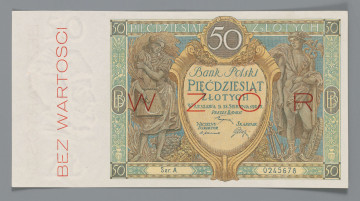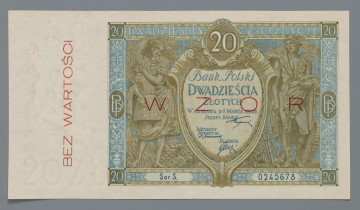
Cheque for 50,000,000 Polish marks - a template
1923
National Museum in Lublin
Part of the collection: Paper money during the Second Polish Republic
In the inter-war period, many types of banknotes appeared in circulation. Initially, it was mainly due to the economic situation of the country, which was being rebuilt after the period of captivity. The need to fight to maintain independence and the difficult economic situation often forced successive governments to resort to temporary solutions, also in state finances. Władysław Grabski’s reform also brought stability to the monetary policy. Another difficult period faced by the Polish state was the Great Economic Crisis initiated on so-called Black Thursday, 24 October 1929. In a sense, the 5-zloty denomination can be considered the first Polish banknote during the Great Depression, as the decision to issue it was taken on 2 January 1930. However, it was not circulated until 15 September 1934, i.e., after the wave of the crisis had passed.
The five-zloty banknote also marked the start of a new custom of Bank Polski to issue individual banknotes, which were created according to different designs that were neither stylistically nor graphically related. The only relatively constant element was a wide, unprinted margin containing a watermark. It usually depicted the ruler of Poland, but even here it was not fully consistent: the 2-zloty banknote of 1936 had no watermark, whereas on the 20 and 50-zloty banknotes of the same year the watermark depicted Emilia Plater and General Jan Henryk Dąbrowski.
In the case of the 5-zloty banknote, its design was created by Ryszard Kleczewski, a designer at the Polish Security Printing Works, and the printing was commissioned to the printing works of the Hungarian National Bank (Magyar Nemzeti Bank). The printing plate was engraved there by an Austrian graphic artist and engraver Franke Ruppert. The main motif on the obverse was an image modelled on the painting Kasztelanka by Jan Matejko.
It is interesting to note that the height and typeface of the letters denoting the series of issue differ between the 1930 five-zloty banknotes. Most have letters 3 mm high, while some series have letters 3.38 mm high. This piece belongs to the CP series, which means that the series letters are 3 mm high.
Leszek Poniewozik
Author / creator
Dimensions
cały obiekt: height: 145 mm, width: 77 mm
Object type
paper money
Technique
Material
paper
Creation time / dating
Creation / finding place
Owner
The National Museum in Lublin
Identification number
Location / status

1923
National Museum in Lublin

1925
National Museum in Lublin

1926
National Museum in Lublin
DISCOVER this TOPIC
National Museum in Lublin
DISCOVER this PATH
Educational path